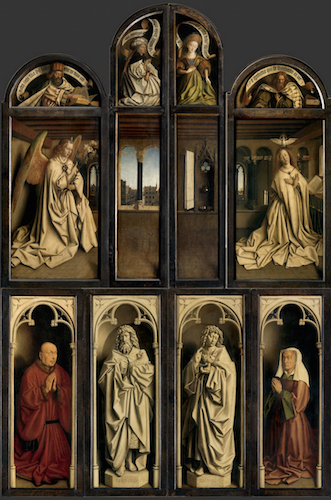late 14th, early 15th century
northern european secular aesthetics- notions of beauty:
- receding hairline
- hair horns= piety
- pale skin
- pear-shaped
- extended abdomen
- no discernible waistline
key artists:
- robert campin (master of flemalle)
- jan van eyck
- rogier van der weyden
- martin schongauer
- hugo van der goes
- albrecht durer
burgundy & flanders:
- flanders derived its wealth from wool & banking
- flanders controlled by the dukes of Burgundy
- flemish artists popularized the use of oil paints on wood panels
- jan van eyck, rogier van der weyden, & others established portraiture as an important art form in 15th century flanders
MATERIALS & TECHNIQUES: TEMPERA & OIL PAINTING
-tempera: consists of egg combined w a wet paste of ground pigment, dried quickly
-oil paints: powdered pigments mixed w linseed oil, dried slowly
-sfumato: smoky effect
-linen canvas became popular in late 16th century
jan van eyck:
- court painter to the duke of burgundy
- master technician of oil painting
- iconic precursor to fame & the artist (first to sign name)
- painter of religious altarpieces & secular portraits
-frames: conceptual & visual functions
-could integrate big paintings w surroundings
-could reinforce illusionistic nature of painting
-could distance view from "otherworldly" scenes by calling attention to separation of image & viewer
fig. 20-8
 |
| the man in a red turban- jan van eyck oil painting, 1433 first known western portrait where sitter looks directly at viewer |
fig. 20-5
 |
| ghent altarpiece (closed)- jan van eyck 1432, oil on wood |
fig. 20-6
 |
| ghent altarpiece (opened)- jan van eyck 1432 top left & right- adam & eve center bottom- christ= sacrificial lamb complementary colors-> excitement/interest foreground, mid., background |
fig. 20-7
 |
| giovanni arnolfini & his wife- jan van eyck 1434, oil painting on wood fur lining= wealth dog= loyalty & fidelity signature: "jan van eyck was here" |
fig. 20-8A
 |
| portrait of a lady- van der weyden ca. 1460 |
fig. 20-9 |
| deposition- rogier van der weyden 1435, oil on wood serpentine "S" shape body= snake= satan elongated body bright colors, dark shadows, more modern day clothing skull- memento mori |
-guilds controlled artistic production in flanders (same in italy)
-guilds secured adequate payments for artists' labor
-women had fewer opportunities than men to become artists (social & moral constraints)
-caterina van hemessen (flemish woman artist): received tutoring from father (professional artist)
france:
- the Limburg brothers expanded illusionistic capabilities of manuscript illumination in the Book of Hours
- french court art owes a debt to flemish painting in style & technique as well as in the integration of sacred & secular themes
holy roman empire:
- the late gothic style remained popular in 15th century germany for cards wood retables
- major german innovation: printing press--> books w woodcut illustrations
- earliest masters of engraving
PROBLEMS & SOLUTIONS: HOW TO ILLUSTRATE PRINTED BOOKS
-invention of moveable type in 15th century
-print: an artwork on paper, usually produced in multiple impressions
-edition: set of prints an artist creates from a single print
-woodcut solved problem of illustrating new printed books-> demise of manuscript illuminator
PRINTMAKING TECHNIQUES:
-relief: carving design into a surface, usually soft wood. images are created in reverse- subtractive
-intaglio: artist incises (cuts) lines on a metal plate (replaces wooden blocks)-> mass production
-tool: burin/stylus
-tool: burin/stylus
-etching: acid bath eats into exposed parts of plate
 |
| saint anthony tormented by demons- martin schongauer 1490, intaglio-engraving |



No comments:
Post a Comment